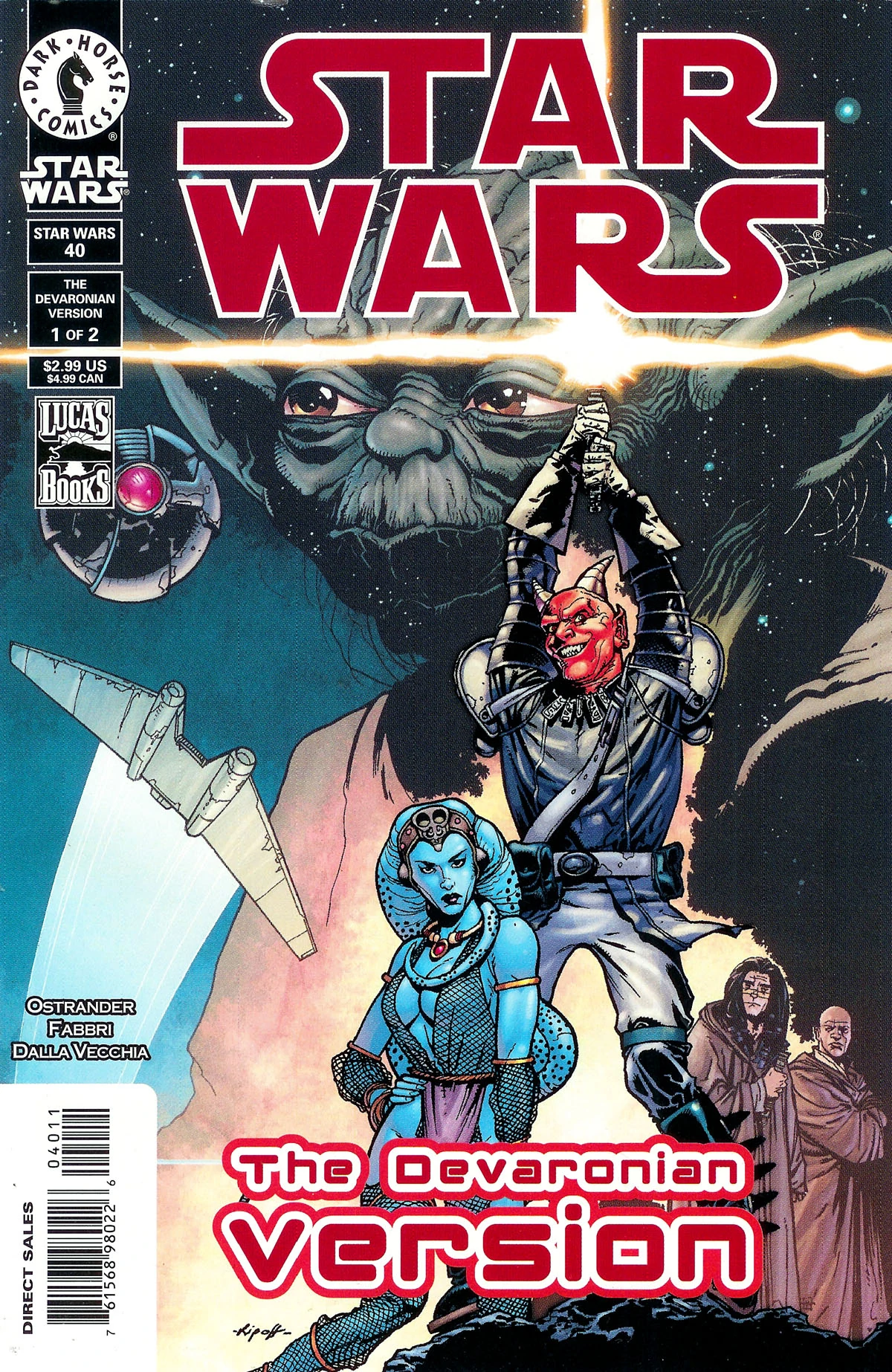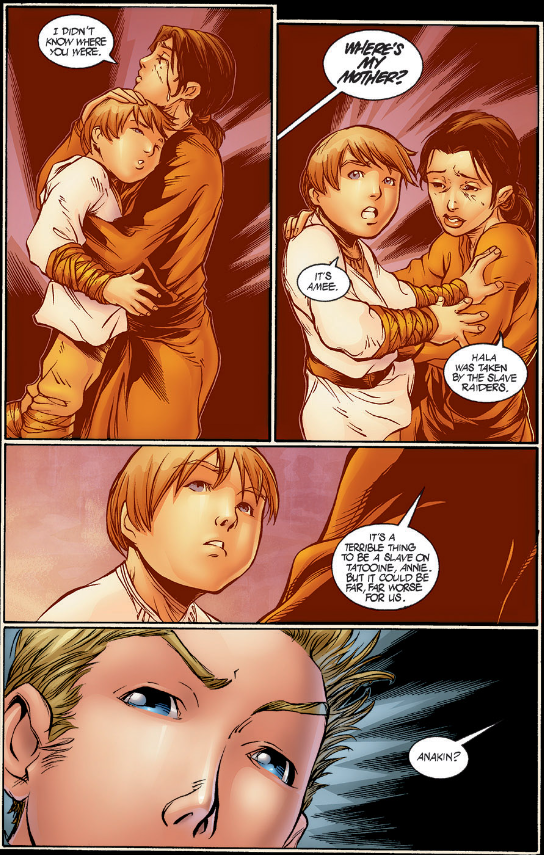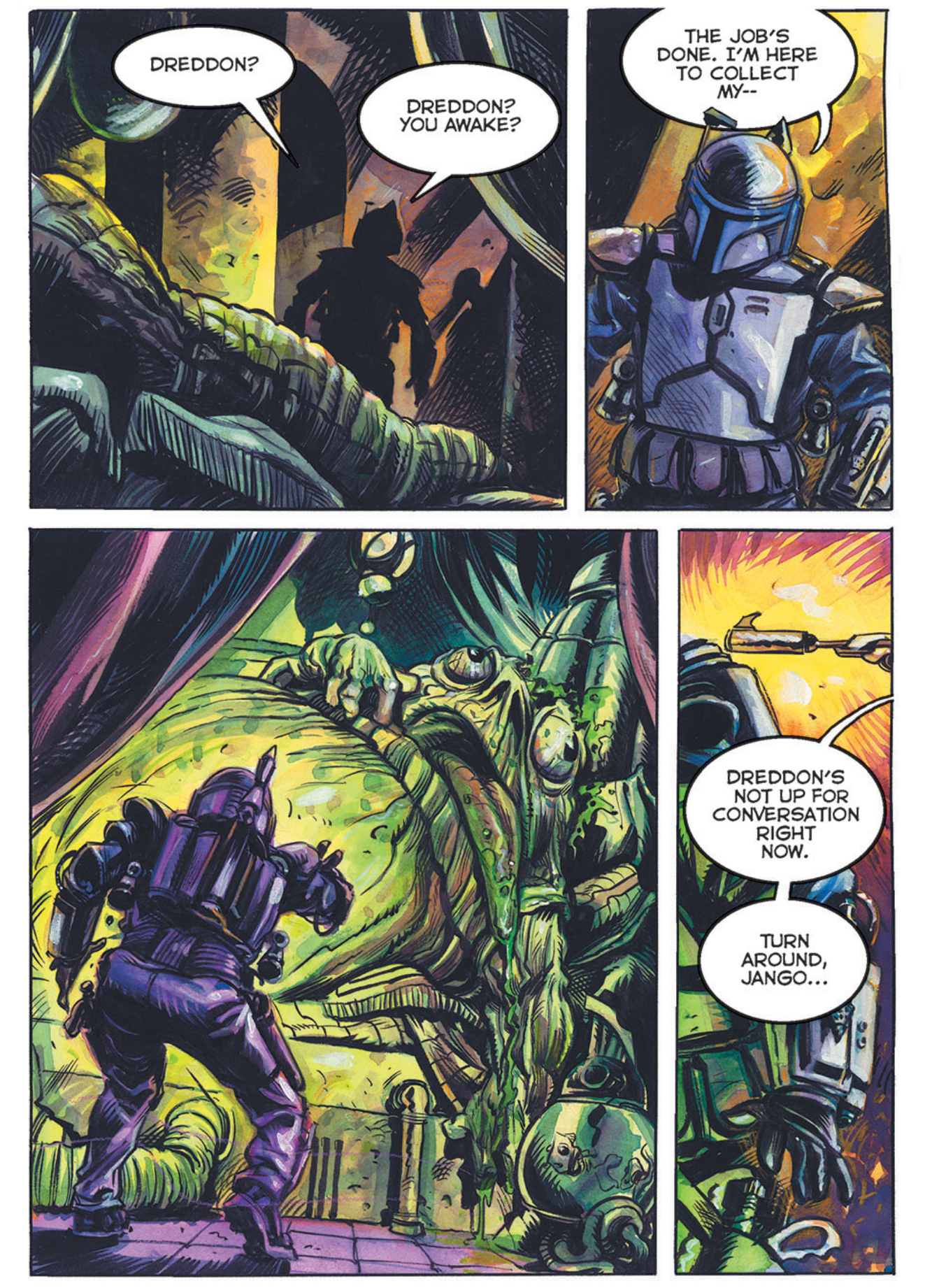Star Wars Legends Epic Collection: The Menace Revealed Vol. 3 TP Review!
One of the fun and interesting – or infuriating, take your pick – things about reading Star Wars comics from the era of this collection is the way they interact with what counts as current canon. Published by Dark Horse Comics in the early 00s, the stories collected in Star Wars Epic Collection: The Menace Revealed vol. 3 have been deemed non-canonical “legends” relative to the stories being told in the current comics from Marvel, as well as the movies and streaming series of the Disney era. They were also published in the early 2000s, just before or right around the release of Star Wars Episode II: Attack of the Clones. Which means they are indirectly non-canonical in a different way: by virtue of having been created before Attack of the Clones, they can’t reference later events, such as the Clone Wars or the details of Anakin’s fall to the dark side.

The end result is a batch of stories that function more as a historical curiosity than anything – both because of the timing of their creation and because, ultimately, the level of craft involved is largely workmanlike and of its time. It’s doubtful that anyone is going to read the stories collected in this volume and be enticed by sparkling scripts, the mind-blowing plots, or stunning art, because they contain very little of those things. These are stories crafted to simply tell entertaining stories in a familiar, well-loved setting and for the most part, they succeed in that goal. But they do little to rise above the circumstances of their creation. Yet that’s not to say they are entirely devoid of value or entertainment, as a closer look can reveal.
The Adventures of Quinlan and Aayla
Launched in 1998 ahead of the release of The Phantom Menace as the first new ongoing Star Wars comic since the original 1977 Marvel book, the simply-titled Star Wars spent the next several years serving as the flagship series of Dark Horse’s comics set in a galaxy far, far away. Specifically, it explored the era of the Prequels between Phantom Menace and the then-upcoming Attack of the Clones, and started to hit their stride with the arrival of writer John Ostrander and penciler Jan Duursema in issue #19, as the pair began chronicling the adventures of Jedi Quinlan Vos, his apprentice Aayla Secura (whose comic book adventures caught George Lucas’ eye, leading to her being written into canon in Attack of the Clones) and their reluctant occasional ally Vilmahr “Villie” Grahrk.
To varying degrees, both those creators and their notable characters are featured in the issues of Star Wars collected in this volume, issues #36-#45, which comprise three different stories, though rarely do all three elements (Ostrander, Duursema, and Quinlan/Aayla) come together. First up is the “Stark Hyperpace War” in issues #36 through #39, written by Ostrander with Davidé Fabbri on pencils, in which the Jedi Council gets drawn into a galactic conflict over the control of the medicinal bacta. Notably, it is a conflict that is not a “full scale war” like the upcoming Clone Wars and that is, frankly, the most interesting thing about it, watching Ostrander try to thread the needle between presenting a sweeping large scale action story that pulls in some of the most powerful and significant of Jedi, while still leaving enough room for it not to overshadow the Clone Wars (or even something like the Yuuzhan Vong War then unfolding in the Star Wars novels). For the most part, he succeeds, though in meeting his goals, he ultimately has to tell a somewhat restrained story that doesn’t quite hit as hard as it could.

Star Wars #40-41 covers “The Devaronian Version”, a story which centers on Villie, a Devaronian (those are the devil-looking aliens, one of whom first appeared in the New Hope cantina) bounty hunter who becomes an uncomfortable sidekick to Quinlan throughout Ostrander’s run. Villie is in many ways the spiritual ancestor of someone like Honda Ohnaka from Clone Wars and Rebels (or even Han Solo or Lando Calrissian), a character operating in the shadows of the Star Wars universe with just enough integrity to reluctantly help the heroes, but not so much they quite become out-and-out heroes. “The Devaronian Version” offers Villie’s take on his recent adventures with Quinlan after he’s accused of going soft and being in the pocket of the Jedi. It’s a story largely played for laughs (or, at least, “amused chuckles”), and it does that job well enough. At just two issues, it also doesn’t overstay its welcome.
Finally, Star Wars #42-45 features “Rite of Passage,” a story which finds the band back together again as Jan Duursema returns to the series and both Quinlan Vos and Aayla Secura return to the spotlight. Duursema is the unsung hero of Dark Horse’s Star Wars stories, consistently bringing strong storytelling fundamentals and a keen eye for design to her work, and “Rite of Passage” gains from the narrative relevance of chronicling the events which lead to Quinlan becoming a Jedi Master and his Padawan Aayla elevated to the rank of Jedi Knight. Their promotions make the story an appropriate bookend for the series; while Ostrander and Duursema will in later issues continue the adventures of Quinlan and Aayla and pickup on plot threads laid down in “Rite of Passage,” that story marks the last time the series’ will be playing in the pre-Attack of the Clones timeline; as of issue #46, the series becomes “Star Wars: Republic” and begins chronicling tales set in the post-Attack of the Clones era, telling stories set amidst the events of the Clone Wars. The Ostrander/Duursema, Quinlan/Aayla combo, combined with the narrative relevance, elevates “Rite of Passage” ahead of the other Star Wars stories collected in this volume.
Jedi Quest
In addition to the ten issue run of Star Wars, Star Wars Legends Epic Collection: The Menace Revealed Vol. 3 includes two other stories set in the same era. Jedi Quest is a four issue limited series starring Obi-Wan Kenobi and a young Anakin Skywalker. Like the others in this volume, it takes place between The Phantom Menace and Attack of the Clones, and is one of the few stories from this era to really embrace the dynamic of a relatively young Obi-Wan and Anakin learning to work together (issue #1 opens with Obi-Wan taking Anakin to the planet Illum, where he constructs his first lightsaber). In it, they become embroiled in a plot to take down an intergalactic slave ring, which involves Anakin being captured and forced back into slavery for a time. Needless to say, it can read a bit heavy at times, but it’s also the story that reads as the most “of its time,” both in its style and its limitations born of when it was written in the context of the larger Star Wars narrative.

Writer Ryder Windham does an effective job of wringing out as much pathos from Anakin’s circumstances as he can, flashing back to his time on Tatooine and featuring some unrevealed snippets of his life with his mother. At the same time, it all reads much differently in hindsight, with the benefit of just how big a deal Anakin’s abandonment of his mother would come to play in the character’s fall to the Dark Side across the remaining Prequel Trilogy. It’s difficult to read the story and not feel like those connections could be tighter/more explicit, even though of course they can’t be, because Windham had no idea of the details of what was to come in Anakin’s story (there’s also a more amusing accidentally-predictive bit in issue #4, in which we see that Obi-Wan has a blue collar pre-Dexter Jettster contact in the bowels of Coruscant).
Art in Jedi Quest comes from Pop Mhan, an artist whose style very much tapped into the manga-esque influence that permeated comics in the late 90s. While his faces occasionally devolve into asymmetry and there can be an unfinished sketchiness to some of his figures, he manages the sequential action well enough. But the style alone and its ties to a very specific post-Joe Madureira era of American comic book art adds a dated feeling to the whole thing. Ultimately, Jedi Quest is emblematic of the volume as a whole, as it’s difficult to read as anything other than a historical curiosity.
A Tale of Two Bounty Hunters
The final story collected in Star Wars Legends Epic Collection: The Menace Revealed Vol. 3 was originally presented as a pair of super-sized 64 page one-shots, one dedicated to Jango Fett, the other to Zam Wesell, the then-new bounty hunters characters poised to debut in Attack of the Clones (as “preview players,” both characters also received special pre-release action figures as well). Written by Ron Marz with art by Tom Fowler (Jango Fett) and Ted Naifeh (Zam Wesell), the story told across the two issues tells of the bounty hunters teaming up first to steal an ancient relic from an alien temple, then to stop that relic from being used to destroy the planet of Coruscant. Marz does his best to use the extra pages to imbue the two characters with some semblance of personality, though of course he’s more successful with Jango, thanks to the lineage of the character and his relationship to Boba than with Zam, who ultimately goes on to be little more than a plot point in Attack of the Clones (Marz does takes advantage of the medium to do a lot more with Zam’s shapeshifting abilities than the film ultimately does, though, which is fun).
The most notable thing about Zam Wesell is, ultimately, that it showcases the death of Yarael Poof (the Jedi Master with the head like a fleshy Q-tip), thereby explaining his absence from the Jedi Council in Episode II. Jango Fett, however, features perhaps the most memorable art of the entire volume, from Tom Fowler. His work is lush and painterly, and lends an almost storybook-like vibe to the issue, which is appropriate for its tale of Indiana Jones-esque tomb raiding. The story is fairly routine and overly long, but it’s gorgeous to look at.

The Menace Revealed
It’s difficult to recommend a volume like this to anyone but diehard Star Wars fans (and they’ve probably already read these stories), featuring as it does a less-than-fertile storytelling era hamstrung by the limitations of the franchise at the time (knowing what’s come in the Dark Horse era almost makes reading this volume worse, as the volume comes right to the cusp of some genuinely good stories set during the Clone Wars, even if they, too, are non-canonical legends).
Yet at the same time, the volume is not without its charms: the work from Ostrander and Duursema is solid, and while the ones includes in this Epic Collection may not represent the best Quinlan Vos/Aayla Secura stories, they’re still entertaining entries that prove the staying power of those characters. In and around some messy art, Jedi Quest does some interesting things by exploring Anakin’s past as a slave and how that’s impacting his development as a Jedi. And while somewhat ponderous, the Jango Fett/Zam Wesell two-hander does at least feature some of the most evocative art of the volume in at least one of its (overlong) chapters.
Are these the best Star Wars stories put out by Dark Horse during their long stewardship of the franchise? Certainly not. But in revisiting them, it becomes clear they do represent, warts and all, a snapshot of a very specific time, for both comics and the Star Wars franchise. And there’s some entertainment to be had in looking at that snapshot and seeing the kinds of stories that arose from the trends and limitations of that time.
The post Star Wars Legends Epic Collection: The Menace Revealed Vol. 3 TP Review! appeared first on Comic Book Herald.